Siena on:
[Wikipedia]
[Google]
[Amazon]
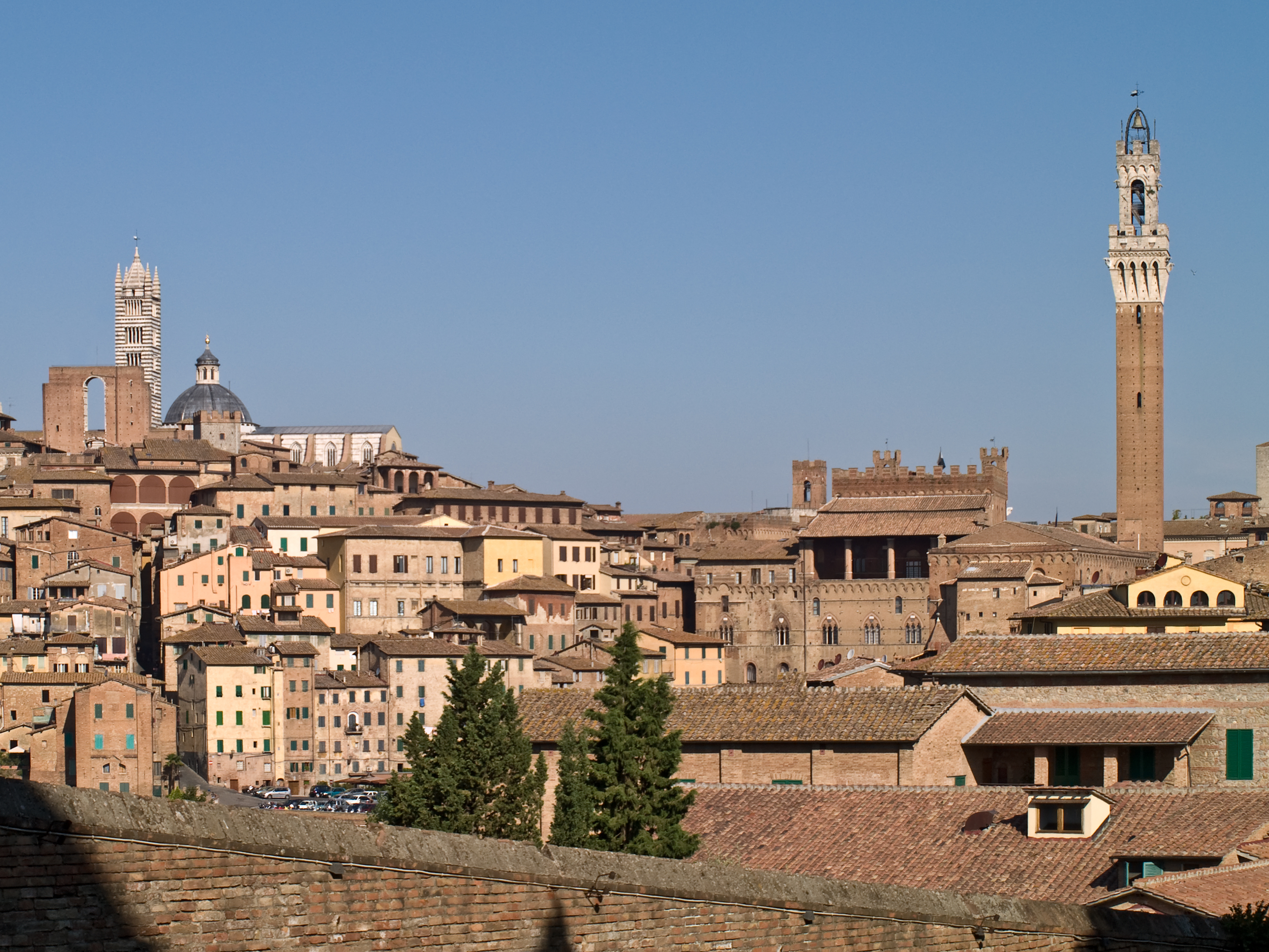
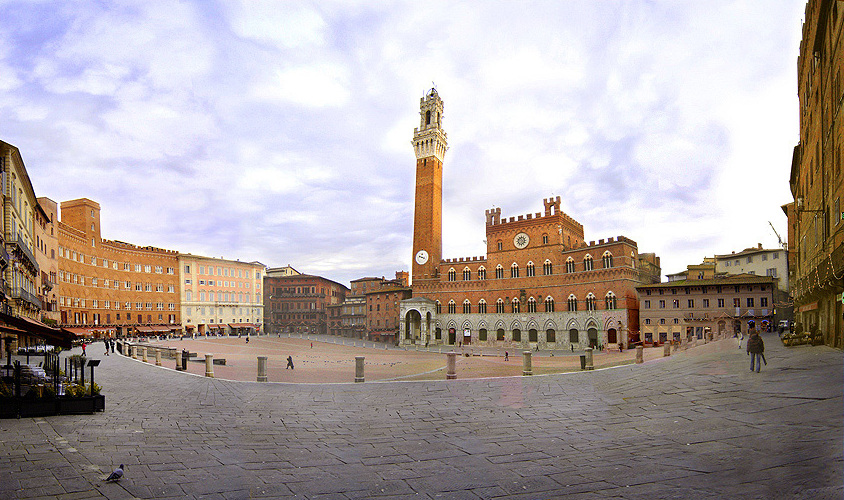 Siena ( , ; lat, Sena Iulia) is a
Siena ( , ; lat, Sena Iulia) is a
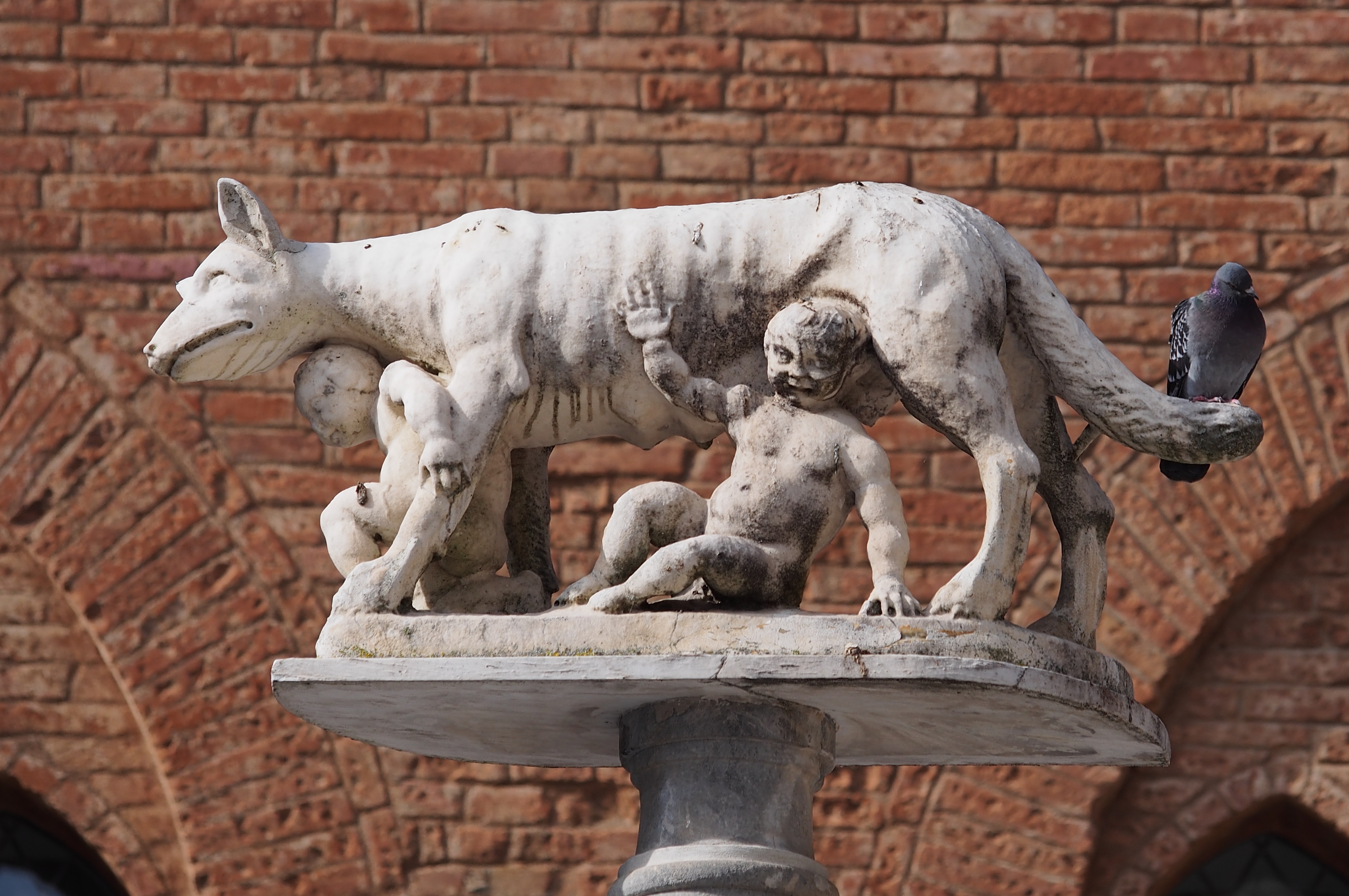
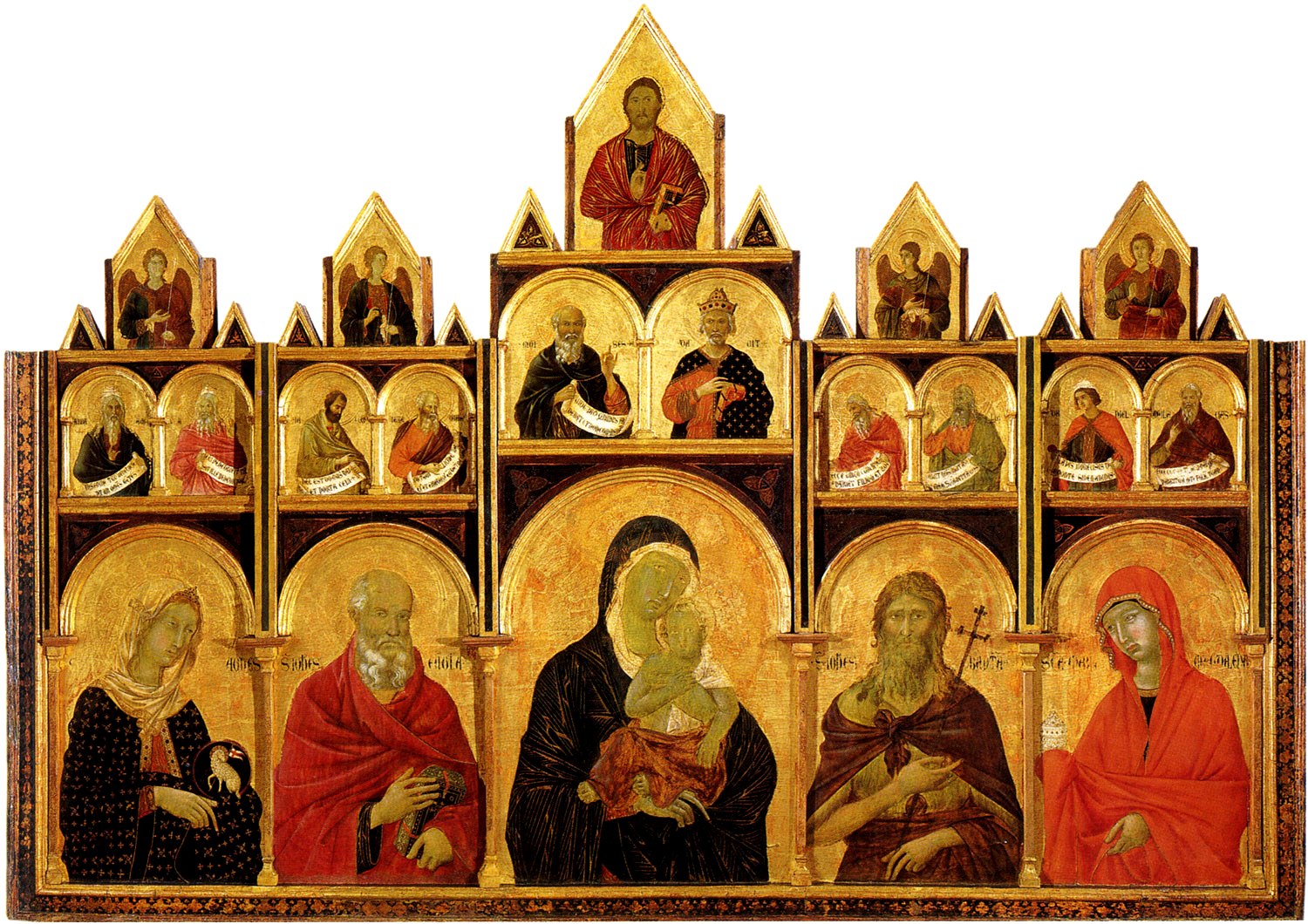
 Over the centuries, Siena has had a rich tradition of arts and artists. The list of artists from the Sienese School include
Over the centuries, Siena has had a rich tradition of arts and artists. The list of artists from the Sienese School include


 The Siena Cathedral ('' Duomo''), begun in the 12th century, is a masterpiece of Italian Romanesque–
The Siena Cathedral ('' Duomo''), begun in the 12th century, is a masterpiece of Italian Romanesque–
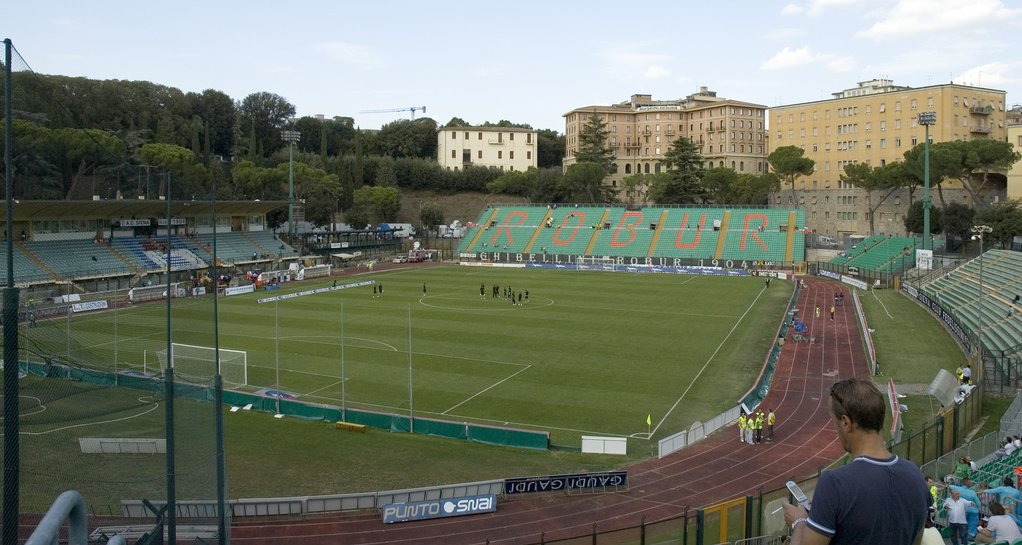
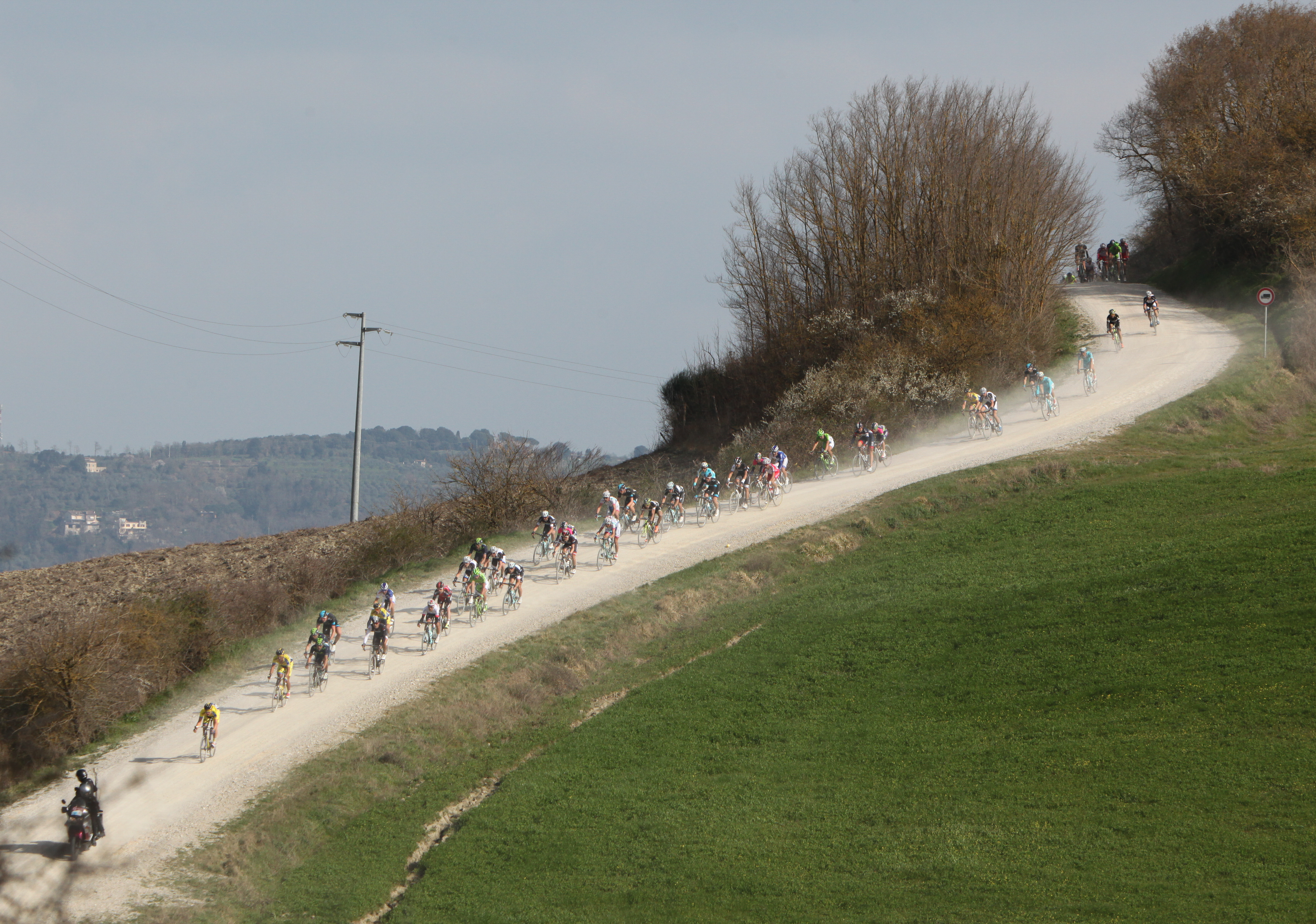 Siena hosts the start and finish of the Strade Bianche, a professional cycling race famous for its historic white gravel roads, called ''strade bianche'' or ''sterrati'' in Italian. More than of the race is run over dirt roads, usually country lanes and farm tracks twisting through the hills and vineyards of the Chianti region. The finish is on the Piazza del Campo, after a steep and narrow climb on the roughly paved Via Santa Caterina leading into the center of the medieval city.
Siena hosts the start and finish of the Strade Bianche, a professional cycling race famous for its historic white gravel roads, called ''strade bianche'' or ''sterrati'' in Italian. More than of the race is run over dirt roads, usually country lanes and farm tracks twisting through the hills and vineyards of the Chianti region. The finish is on the Piazza del Campo, after a steep and narrow climb on the roughly paved Via Santa Caterina leading into the center of the medieval city.
File:Siena Palazzo-Pubblico-Duomo-JBU01.jpg, Siena, Campanile Palazzo Pubblico & Duomo
File:Siena Palazzo-Pubblico-Campanile-JBU02.jpg, Siena, Campanile, Torre del Mangia (Palazzo Pubblico)
File:Siena Duomo JBU03.jpg, Siena, Duomo
File:Interior of the dome, Duomo, Siena, Italy.jpg, The interior of the dome in the Siena cathedral
File:Interior of the dome, Siena Cathedral, Italy.jpg, Interior of the dome at the duomo, Siena
File:Siena city center view from top of Torre del Mangia, Siena, Italy.jpg, Panorama of Siena
File:Italy tuscany siena1.jpg, Piazza del Campo
File:San Domenico church in Siena, Italy.jpg,

 Siena ( , ; lat, Sena Iulia) is a
Siena ( , ; lat, Sena Iulia) is a city
A city is a human settlement of notable size.Goodall, B. (1987) ''The Penguin Dictionary of Human Geography''. London: Penguin.Kuper, A. and Kuper, J., eds (1996) ''The Social Science Encyclopedia''. 2nd edition. London: Routledge. It can be de ...
in Tuscany
it, Toscano (man) it, Toscana (woman)
, population_note =
, population_blank1_title =
, population_blank1 =
, demographics_type1 = Citizenship
, demographics1_footnotes =
, demographics1_title1 = Italian
, demogra ...
, Italy. It is the capital of the province of Siena.
The city is historically linked to commercial and banking activities, having been a major banking center until the 13th and 14th centuries. Siena is also home to the oldest bank in the world, the Monte dei Paschi bank, which has been operating continuously since 1472.
Several significant Renaissance
The Renaissance ( , ) , from , with the same meanings. is a period in European history marking the transition from the Middle Ages to modernity and covering the 15th and 16th centuries, characterized by an effort to revive and surpass id ...
painters worked and were born in Siena, among them Duccio
Duccio di Buoninsegna ( , ; – ) was an Italian painter active in Siena, Tuscany, in the late 13th and early 14th century. He was hired throughout his life to complete many important works in government and religious buildings around Italy. Du ...
, Ambrogio Lorenzetti, Simone Martini and Sassetta, and influenced the course of Italian and European art.
The University of Siena, originally called ''Studium Senese'', was founded in 1240, making it one of the oldest universities in continuous operation
This article contains a list of the oldest existing universities in continuous operation in the world. Inclusion in this list is determined by the date at which the educational institute first met the traditional definition of a university used ...
in the world.
Siena was one of the most important cities in medieval
In the history of Europe, the Middle Ages or medieval period lasted approximately from the late 5th to the late 15th centuries, similar to the post-classical period of global history. It began with the fall of the Western Roman Empire a ...
Europe, and its historic centre is a UNESCO World Heritage Site
A World Heritage Site is a landmark or area with legal protection by an international convention administered by the United Nations Educational, Scientific and Cultural Organization (UNESCO). World Heritage Sites are designated by UNESCO for ...
. From January until the end of September of 2021 it had about 217,000 arrivals, with the largest numbers of foreign visitors coming from Germany, France and the Netherlands. Siena is famous for its cuisine, art, museums, medieval cityscape and the Palio, a horse race held twice a year in Piazza del Campo.
History

Antiquity
Siena, like other Tuscan hill towns, was first settled in the time of theEtruscans
The Etruscan civilization () was developed by a people of Etruria in ancient Italy with a common language and culture who formed a federation of city-states. After conquering adjacent lands, its territory covered, at its greatest extent, roug ...
(c. 900–400 BC) when it was inhabited by a tribe called the Saina. A Roman town called ''Saena Julia'' was founded at the site in the time of the Emperor Augustus
Caesar Augustus (born Gaius Octavius; 23 September 63 BC – 19 August AD 14), also known as Octavian, was the first Roman emperor; he reigned from 27 BC until his death in AD 14. He is known for being the founder of the Roman Pr ...
.
According to local legend, Siena was founded by Senius and Aschius
Senius and Aschius are the two legendary founders of Siena, Italy. They were brothers, sons of Remus, and thus Romulus was their uncle.
Traditions developed in Siena, which can not be documented prior to the 16th century hold that after Romulu ...
, two sons of Remus and thus nephews of Romulus
Romulus () was the legendary founder and first king of Rome. Various traditions attribute the establishment of many of Rome's oldest legal, political, religious, and social institutions to Romulus and his contemporaries. Although many of these ...
, after whom Rome was named. Supposedly after their father's murder by Romulus, they fled Rome, taking with them the statue of the she-wolf suckling the infants ( Capitoline Wolf), thus appropriating that symbol for the town. Additionally they rode white and black horses, giving rise to the ''Balzana'', or coat of arms of Siena with a white band atop a dark band. Some claim the name Siena derives from Senius. Other etymologies derive the name from the Etruscan family name ''Saina'', the Roman family name ''Saenii'', or the Latin
Latin (, or , ) is a classical language belonging to the Italic branch of the Indo-European languages. Latin was originally a dialect spoken in the lower Tiber area (then known as Latium) around present-day Rome, but through the power ...
word ''senex'' "old" or its derived form ''seneo'' "to be old".
Siena did not prosper under Roman rule. It was not sited near any major roads and lacked opportunities for trade. Its insular status meant that Christianity did not penetrate until the 4th century AD, and it was not until the Lombards
The Lombards () or Langobards ( la, Langobardi) were a Germanic people who ruled most of the Italian Peninsula from 568 to 774.
The medieval Lombard historian Paul the Deacon wrote in the '' History of the Lombards'' (written between 787 an ...
invaded Siena and the surrounding territory that it knew prosperity. After the Lombard occupation, the old Roman road
Roman roads ( la, viae Romanae ; singular: ; meaning "Roman way") were physical infrastructure vital to the maintenance and development of the Roman state, and were built from about 300 BC through the expansion and consolidation of the Roman R ...
s of Via Aurelia and the Via Cassia
The ''Via Cassia'' ("way of Cassius") was an important Roman road striking out of the '' Via Flaminia'' near the Milvian Bridge in the immediate vicinity of Rome and, passing not far from Veii, traversed Etruria. The ''Via Cassia'' passed thro ...
passed through areas exposed to Byzantine raids, so the Lombards rerouted much of their trade between the Lombards' northern possessions and Rome along a more secure road through Siena. Siena prospered as a trading post, and the constant streams of pilgrims passing to and from Rome provided a valuable source of income in the centuries to come.
Middle Ages
The oldest aristocratic families in Siena date their line to the Lombards' surrender in 774 toCharlemagne
Charlemagne ( , ) or Charles the Great ( la, Carolus Magnus; german: Karl der Große; 2 April 747 – 28 January 814), a member of the Carolingian dynasty, was King of the Franks from 768, King of the Lombards from 774, and the first Em ...
. At this point, the city was inundated with a swarm of Frankish overseers who married into the existing Sienese nobility and left a legacy that can be seen in the abbeys they founded throughout the Sienese territory. Feudal power waned, however, and by the death of Countess Matilda
Matilda of Tuscany ( it, Matilde di Canossa , la, Matilda, ; 1046 – 24 July 1115 or Matilda of Canossa after her ancestral castle of Canossa), also referred to as ("the Great Countess"), was a member of the House of Canossa (also known as ...
in 1115 the border territory of the March of Tuscany which had been under the control of her family, the Canossa, broke up into several autonomous regions. This ultimately resulted in the creation of the Republic of Siena
The Republic of Siena ( it, Repubblica di Siena, la, Respublica Senensis) was a historic state consisting of the city of Siena and its surrounding territory in Tuscany, central Italy. It existed for over 400 years, from 1125 to 1555. During its ...
.
The Republic existed for over four hundred years, from the 12th century until 1555. During the golden age of Siena before the Black Death in 1348, the city was home to 50,000 people. A major economic centre and among the most important cities in Europe, as well as the main political, economic, and artistic rival of its neighboring city of Florence.
In the Italian War of 1551–59, the republic was defeated by the rival Florence
Florence ( ; it, Firenze ) is a city in Central Italy and the capital city of the Tuscany region. It is the most populated city in Tuscany, with 383,083 inhabitants in 2016, and over 1,520,000 in its metropolitan area.Bilancio demografico ...
in alliance with the Spanish crown. After 18 months of resistance, Siena surrendered to Spain on 17 April 1555, marking the end of the republic.
Medicean period
After the fall of the Republic, a few Sienese led by the Florentine exile Piero Strozzi, not wanting to accept the fall of the Republic, took refuge in Montalcino, creating the Republic of Siena sheltered in Montalcino. It lived until 31 May 1559 when it was betrayed by the French allies, whom Siena had always supported, concluding with the Peace of Cateau Cambrésis with Charles V, which effectively ceded the Republic to the Medici. TheHouse of Medici
The House of Medici ( , ) was an Italian banking family and political dynasty that first began to gather prominence under Cosimo de' Medici, in the Republic of Florence during the first half of the 15th century. The family originated in the ...
, apart from the brief parenthesis of Ferdinando I
Ferdinando may refer to:
Politics
* Ferdinando I de' Medici, Grand Duke of Tuscany (1549–1609)
* Ferdinando II de' Medici, Grand Duke of Tuscany (1610–1670)
* Ferdinando de' Medici, Grand Prince of Tuscany (1663–1713), eldest son of Cosimo ...
, who tried to create an organized state, were not able to give a stable structure to the Grand Duchy of Tuscany
The Grand Duchy of Tuscany ( it, Granducato di Toscana; la, Magnus Ducatus Etruriae) was an Italian monarchy that existed, with interruptions, from 1569 to 1859, replacing the Republic of Florence. The grand duchy's capital was Florence. In t ...
, keeping almost unchanged the division between the so-called Old State, i.e. Florence, and the New State, i.e. Siena and the southern part up to Pitigliano, with different laws and taxes. With the death of Gian Gastone de' Medici, (1737), who had no children, the Medici dynasty ended and the Grand Duchy passed into the hands of the Habsburg-Lorraine dynasty who kept it until 1799.
Late modern period
After the Napoleonic period and the Risorgimento uprisings, Siena was the first city in Tuscany, in 1859, to vote in favour of annexation to theKingdom of Italy
The Kingdom of Italy ( it, Regno d'Italia) was a state that existed from 1861, when Victor Emmanuel II of Sardinia was proclaimed King of Italy, until 1946, when civil discontent led to an institutional referendum to abandon the monarchy and ...
.
Geography
Siena is located in the central part ofTuscany
it, Toscano (man) it, Toscana (woman)
, population_note =
, population_blank1_title =
, population_blank1 =
, demographics_type1 = Citizenship
, demographics1_footnotes =
, demographics1_title1 = Italian
, demogra ...
, in the middle of a vast hilly landscape between the Arbia river valley (south), the Merse valley (south-west), the Elsa valley (north), the Chianti hills (north-east), the Montagnola Senese (west) and the Crete Senesi (south-east). The city lies at above sea level.
Climate
Siena has a typical inland Mediterranean climate. Average rainfall is , with the maximum in November and the minimum in July. July is the hottest month, with an average temperature of , and January the coldest.Economy
The main activities are tourism, services, agriculture, handicrafts and light industry. In 2009 agricultural activity comprised 919 companies with a total area of for a usable agricultural area of or about of the total municipal area (data ISTAT for the 2000 Agriculture Census ''V''). There is little manufacturing in the city. One exception is the seasonal confectionery industry, which produces local specialities includingpanforte
Panforte is a traditional chewy Italy, Italian dessert containing fruits and nuts. It is similar to a Florentine biscuit, florentine but much thicker, or a little like a lebkuchen. Known throughout all Italy, it is a Christmas tradition associate ...
, ricciarelli and cavallucci at Christmas, and pane co' santi for I Santi on 1 November and I Morti on the following day.
The area has also seen a growth in biotechnology
Biotechnology is the integration of natural sciences and engineering sciences in order to achieve the application of organisms, cells, parts thereof and molecular analogues for products and services. The term ''biotechnology'' was first used b ...
. The Centenary Institute Sieroterapico Achille Sclavo used to be Swiss-owned, operating under the company name, Novartis
Novartis AG is a Swiss-American multinational pharmaceutical corporation based in Basel, Switzerland and
Cambridge, Massachusetts, United States (global research).name="novartis.com">https://www.novartis.com/research-development/research-loc ...
Vaccines. Novartis developed and produced vaccines and employed about a thousand people. In 2015, the research plant in Siena became part of Glaxo Smith Kline, as part of a deal between Novartis
Novartis AG is a Swiss-American multinational pharmaceutical corporation based in Basel, Switzerland and
Cambridge, Massachusetts, United States (global research).name="novartis.com">https://www.novartis.com/research-development/research-loc ...
and this firm.
Government
Culture
Contrade
Siena retains a ward-centric culture from medieval times. Each ward (''contrada'') is represented by an animal or mascot and has its own boundary and distinct identity. Ward rivalries are most rampant during the annual horse race (Palio) in the Piazza del Campo. There are 17 wards (contrada): Aquila, Bruco, Chiocciola, Civetta, Drago, Giraffa, Istrice, Leocorno, Lupa, Nicchio, Oca, Onda, Pantera, Selva, Tartuca, Torre, Valdimontone.The Palio
The Palio di Siena is a traditional medieval horse race run around the Piazza del Campo twice each year, on 2 July and 16 August. The event is attended by large crowds, and is widely televised. Ten randomly selected from 17 Contrade (which are city neighbourhoods originally formed asbattalion
A battalion is a military unit, typically consisting of 300 to 1,200 soldiers commanded by a lieutenant colonel, and subdivided into a number of companies (usually each commanded by a major or a captain). In some countries, battalions are ...
s for the city's defence) vie for the trophy: a painted banner, or '' Palio'' bearing an image of the Blessed Virgin Mary.
Art

 Over the centuries, Siena has had a rich tradition of arts and artists. The list of artists from the Sienese School include
Over the centuries, Siena has had a rich tradition of arts and artists. The list of artists from the Sienese School include Duccio
Duccio di Buoninsegna ( , ; – ) was an Italian painter active in Siena, Tuscany, in the late 13th and early 14th century. He was hired throughout his life to complete many important works in government and religious buildings around Italy. Du ...
and his student Simone Martini, Pietro Lorenzetti and Martino di Bartolomeo. A number of well-known works of Renaissance
The Renaissance ( , ) , from , with the same meanings. is a period in European history marking the transition from the Middle Ages to modernity and covering the 15th and 16th centuries, characterized by an effort to revive and surpass id ...
and High Renaissance art still remain in galleries or churches in Siena.
The Church of ''San Domenico'' contains art by Guido da Siena, dating to the mid-13th century. Duccio's ''Maestà'', which was commissioned by the City of Siena in 1308, was instrumental in leading Italian painting away from the hieratic representations of Byzantine art
Byzantine art comprises the body of Christian Greek artistic products of the Eastern Roman Empire, as well as the nations and states that inherited culturally from the empire. Though the empire itself emerged from the decline of Rome and lasted ...
and directing it towards more direct presentations of reality. And his ''Madonna and Child with Saints'' polyptych, painted between 1311 and 1318, remains at the city's ''Pinacoteca Nazionale''.
The Pinacoteca also includes several works by Domenico Beccafumi, as well as art by Lorenzo Lotto, Domenico di Bartolo and Fra Bartolomeo.
Main sights


 The Siena Cathedral ('' Duomo''), begun in the 12th century, is a masterpiece of Italian Romanesque–
The Siena Cathedral ('' Duomo''), begun in the 12th century, is a masterpiece of Italian Romanesque–Gothic architecture
Gothic architecture (or pointed architecture) is an architectural style that was prevalent in Europe from the late 12th to the 16th century, during the High and Late Middle Ages, surviving into the 17th and 18th centuries in some areas. I ...
. Its main façade was completed in 1380 with a nave oriented northeast–southwest. A proposed expansion of the eastern transept would have transformed the church into an ambitiously massive basilica, the largest then in the world, with an east–west nave. However, the scarcity of funds, in part due to war and the Black Death, truncated the project. Two walls of this expanded eastern transept remain; through an internal staircase, visitors can climb for a grand view of the city.
The Siena Cathedral Pulpit is an octagonal 13th-century masterpiece sculpted by Nicola Pisano with lion pedestals and biblical bas-relief panels. The inlaid marble mosaic floor of the cathedral, designed and laboured on by many artists, is among the most elaborate in Italy. The Sacristy and Piccolomini library have well-preserved Renaissance
The Renaissance ( , ) , from , with the same meanings. is a period in European history marking the transition from the Middle Ages to modernity and covering the 15th and 16th centuries, characterized by an effort to revive and surpass id ...
frescos by Ghirlandaio and Pinturicchio respectively. Other sculptors active in the church and in the subterranean baptistry
In Christian architecture the baptistery or baptistry (Old French ''baptisterie''; Latin ''baptisterium''; Greek , 'bathing-place, baptistery', from , baptízein, 'to baptize') is the separate centrally planned structure surrounding the baptisma ...
are Donatello
Donato di Niccolò di Betto Bardi ( – 13 December 1466), better known as Donatello ( ), was a Florentine sculptor of the Renaissance period. Born in Florence, he studied classical sculpture and used this to develop a complete Renaissance st ...
, Lorenzo Ghiberti, Jacopo della Quercia and others. The Museo dell'Opera del Duomo contains Duccio's famous '' Maestà'' (1308–11) and various other works by Sienese masters. More Sienese paintings are to be found in the Pinacoteca, e.g. 13th-century works by Dietisalvi di Speme.
The Piazza del Campo, the shell-shaped town square, unfurls before the Palazzo Pubblico with its tall Torre del Mangia. This is part of the site for the ''Palio'' horse race. The Palazzo Pubblico, itself a great work of architecture, houses yet another important art museum. Included within the museum is Ambrogio Lorenzetti's frescoes depicting the ''Allegory and Effects of Good and Bad Government'' and also some of the finest frescoes of Simone Martini and Pietro Lorenzetti.
The Palazzo Salimbeni, located in a piazza of the same name, was the original headquarters and remains in possession of the Monte dei Paschi di Siena, one of the oldest banks in continuous existence in Europe.
Housed in the notable Gothic
Gothic or Gothics may refer to:
People and languages
*Goths or Gothic people, the ethnonym of a group of East Germanic tribes
**Gothic language, an extinct East Germanic language spoken by the Goths
**Crimean Gothic, the Gothic language spoken b ...
Palazzo Chigi-Saracini on Via di Città is the Accademia Musicale Chigiana
The Accademia Musicale Chigiana (''English'': Chigiana Musical Academy) is a music institute in Siena, Italy. It was founded by Count Guido Chigi-Saracini in 1932 as an international centre for advanced musical studies. It organises Master Clas ...
, Siena's conservatory of music.
Other churches in the city include:
* Basilica dell'Osservanza
* San Domenico San Domenico may refer to:
Catholic saints
* Dominic de Guzmán (1170-1221), Spanish priest and founder of the Dominican Order
* San Domenico di Sora (951-1031), Italian abbot, patron saint of Villalago
Churches
* San Domenico, Arezzo (Basilica ...
* San Francesco
* San Martino
* Santa Maria dei Servi Santa Maria dei Servi may refer to the following churches in Italy:
* Santa Maria dei Servi, Bologna
* Santa Maria dei Servi (Siena)
The Church of Santa Maria dei Servi is a Romanesque style, Roman Catholic church in the Terzo of San Martino ...
* Santa Petronilla
* Santi Niccolo e Lucia
* Santo Spirito
* Sant'Andrea Apostolo Sant'Andrea is the Italian name for St. Andrew, most commonly Andrew the Apostle. It may refer to:
Communes in Italy
*Castronuovo di Sant'Andrea, Basilicata
* Cazzano Sant'Andrea, Lombardy
* Mazzarrà Sant'Andrea, Sicily
* Penna Sant'Andrea, Ab ...
* Sanctuary of ''Santa Caterina'', incorporating the old house of St. Catherine of Siena. It houses the miraculous ''Crucifix'' (late 12th century) from which the saint received her stigmata, and a 15th-century statue of St. Catherine.
The historic Siena synagogue is also preserved and open to visitors.
The city's gardens include the Orto Botanico dell'Università di Siena
The Orto Botanico dell'Università di Siena (2.5 hectares) is a botanical garden operated by the University of Siena. It is located at Via P. A. Mattioli, 4, Siena, Tuscany, Italy, and open daily.
The garden's history reaches back to 1588 whe ...
, a botanical garden
A botanical garden or botanic gardenThe terms ''botanic'' and ''botanical'' and ''garden'' or ''gardens'' are used more-or-less interchangeably, although the word ''botanic'' is generally reserved for the earlier, more traditional gardens, an ...
maintained by the University of Siena.
The Medicean Fortress houses the Siena Jazz School, with courses and concerts throughout the year, and a festival during the International Siena Jazz Masterclasses.
In the neighbourhood are numerous patrician villas, some of which are attributed to Baldassarre Peruzzi:
* Villa Chigi
A villa is a type of house that was originally an ancient Roman upper class country house. Since its origins in the Roman villa, the idea and function of a villa have evolved considerably. After the fall of the Roman Republic, villas became ...
* Castle of Belcaro
* Villa Celsa
* Villa Cetinale
* Villa Volte Alte
Sports

Football
Associazione Calcio Siena ( football) was founded in 1904 and fully established in 1908. It was first promoted to Italy's top league, Serie A, for the 2003–04 season and stayed in this serie for nine seasons. After the club's bankruptcy in 2014, a new club named Società Sportiva Robur Siena took its place and had to restart fromSerie D
The Serie D () is the top level of semi-professional football in the country. The fourth tier of the Italian league system, the competition sits beneath the third professional league, Serie C. It is administered by the Lega Nazionale Dilettant ...
. Currently, it is in Lega Pro league. The club hosts its games at the Stadio Artemio Franchi.
Basketball
The premier society of men's basketball in Siena was called Mens Sana Basket (also referred to by its sponsored name of ''Montepaschi Siena''). It is also the oldest sports society in Siena. Mens Sana Basket participated in the highest level of play in Italy, Lega Basket Serie A, and it has won the national championship eight times, with a streak of seven (2004 and 2007–13). The team host their home games atPalaEstra
A palaestra ( or ;
also (chiefly British) palestra; grc-gre, παλαίστρα) was any site of an ancient Greek wrestling school. Events requiring little space, such as boxing and wrestling, took place there. Palaestrae functioned both indep ...
indoor arena. Like the local football team, the club went through financial issues in 2014, and its place was taken by the new club Mens Sana 1871, currently in the Serie A2 league. The city co-hosted the EuroBasket 1979.
Cycling
 Siena hosts the start and finish of the Strade Bianche, a professional cycling race famous for its historic white gravel roads, called ''strade bianche'' or ''sterrati'' in Italian. More than of the race is run over dirt roads, usually country lanes and farm tracks twisting through the hills and vineyards of the Chianti region. The finish is on the Piazza del Campo, after a steep and narrow climb on the roughly paved Via Santa Caterina leading into the center of the medieval city.
Siena hosts the start and finish of the Strade Bianche, a professional cycling race famous for its historic white gravel roads, called ''strade bianche'' or ''sterrati'' in Italian. More than of the race is run over dirt roads, usually country lanes and farm tracks twisting through the hills and vineyards of the Chianti region. The finish is on the Piazza del Campo, after a steep and narrow climb on the roughly paved Via Santa Caterina leading into the center of the medieval city.
Transport
;Buses Siena Mobilità was a consortium established in 2005, formed by Tiemme Toscana Mobilità, Busitalia Sita Nord e ByBus, to manage the local public transport in Siena, in its province and regional service toFlorence
Florence ( ; it, Firenze ) is a city in Central Italy and the capital city of the Tuscany region. It is the most populated city in Tuscany, with 383,083 inhabitants in 2016, and over 1,520,000 in its metropolitan area.Bilancio demografico ...
and Arezzo
Arezzo ( , , ) , also ; ett, 𐌀𐌓𐌉𐌕𐌉𐌌, Aritim. is a city and ''comune'' in Italy and the capital of the Province of Arezzo, province of the same name located in Tuscany. Arezzo is about southeast of Florence at an elevation o ...
. From 1 January 2018 Siena Mobilità operated by virtue of the bridge contract between the Regione Toscana
it, Toscano (man) it, Toscana (woman)
, population_note =
, population_blank1_title =
, population_blank1 =
, demographics_type1 = Citizenship
, demographics1_footnotes =
, demographics1_title1 = Italian
, demogra ...
and the company ONE Scarl.
Since 1 November 2021 the public local transport is operated by Autolinee Toscane
Autolinee Toscane S.p.A. (also known as AT) is a private Italian company, wholly owned by RATP Dev, active in the local public transport sector. It manages several urban and suburban bus lines in Tuscany for a total of 1.7 million kilometres trav ...
.
Twin towns
Siena istwinned
Twinning (making a twin of) may refer to:
* In biology and agriculture, producing two offspring (i.e., twins) at a time, or having a tendency to do so;
* Twin towns and sister cities, towns and cities involved in town twinning
* Twinning inst ...
with:
* Avignon
Avignon (, ; ; oc, Avinhon, label=Provençal or , ; la, Avenio) is the prefecture of the Vaucluse department in the Provence-Alpes-Côte d'Azur region of Southeastern France. Located on the left bank of the river Rhône, the commune ha ...
, France
* Concord, North Carolina
Concord is the county seat and largest city in Cabarrus County, North Carolina, Cabarrus County, in the U.S. state of North Carolina. As of the 2020 United States Census, 2020 census, the city had a population of 105,186, with an estimated popu ...
, US, since 2016
* Weimar
Weimar is a city in the state (Germany), state of Thuringia, Germany. It is located in Central Germany (cultural area), Central Germany between Erfurt in the west and Jena in the east, approximately southwest of Leipzig, north of Nuremberg an ...
, Germany, since 1994
* Wetzlar, Germany, since 1987
Gallery
Basilica of San Domenico
The Basilica of San Domenico is one of the major churches in Bologna, Italy. The remains of Saint Dominic, founder of the Order of Preachers ( Dominicans), are buried inside the exquisite shrine Arca di San Domenico, made by Nicola Pisano and hi ...
File:201105 Toscane Sienne.jpg, View from the Campanile del Mangia
References
Sources
* ''A Medieval Italian Commune: Siena under the Nine, 1287–1355'' by ProfessorWilliam M. Bowsky
William is a masculine given name of Norman French origin.Hanks, Hardcastle and Hodges, ''Oxford Dictionary of First Names'', Oxford University Press, 2nd edition, , p. 276. It became very popular in the English language after the Norman conques ...
(1982)
* McIntyre, Anthony Osler. ''Medieval Tuscany and Umbria'' (1992)
*
External links
* {{Authority control Populated places established in the 1st millennium BC Roman sites of Tuscany World Heritage Sites in Italy 1st-millennium BC establishments Capitals of former nations Cities and towns in Tuscany Tuscany